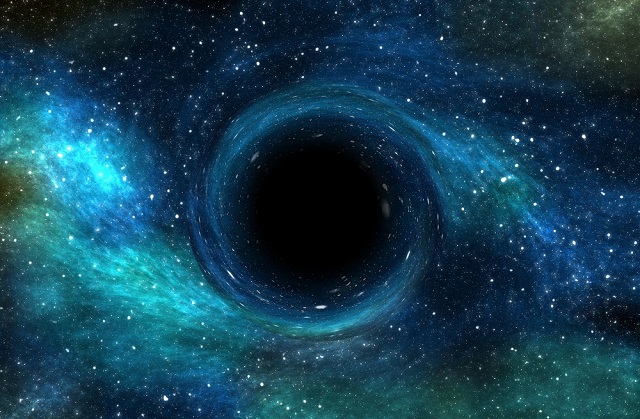
Shutterstock | vchal
Researchers have demonstrated how the behavior of unusually-shaped black holes could disprove Einstein’s general theory of relativity, the cornerstone of modern physics. However, such an object could only be present in a universe with at least five dimensions.
The researchers, from the University of Cambridge and Queen Mary University of London, performed a successful simulation of a black hole, which had the shape of a very thin ring.
Over the course of the simulation the black hole created many ‘bulges’ which were joined together by increasingly thin strings. As the strings became thinner and thinner they eventually pinched off into several miniature black holes; just as a thin water stream from a tap gets broken up into many droplets.
Theoretical physicists discovered ring-shaped black holes in 2002, but this present research is the first instance in which the dynamics of these black holes have been simulated. If this type of black hole were to form, it could result in the formation of a ‘naked singularity’; which would lead to the breakdown of the equations concerning general relativity.
General relativity is the basis of the current understanding of gravity. Einstein’s equations underpin a lot of modern knowledge from the GPS signals that are relied upon for navigation to the estimation of a stars’ age in the universe. It tells us that matter is made to warp its surrounding spacetime, and this warping is observed as gravity. and gravity is the effect of such a wrap.
Time, space and the laws of physics breakdown at a singularity; which is a singular point of extreme gravity. According to general relativity, singularities are present at black holes’ centers with an event horizon surrounding the singularity. The event horizon is a ‘point of no return’, beyond which gravity becomes so intense that even if you were to travel at the speed of light escape is not possible. As even light cannot escape their pull singularities should be invisible from an outside perspective.
As long as singularities stay hidden behind an event horizon, they do not cause trouble and general relativity holds - the ‘cosmic censorship conjecture’ says that this is always the case. As long as the cosmic censorship conjecture is valid, we can safely predict the future outside of black holes. Because ultimately, what we’re trying to do in physics is to predict the future given knowledge about the state of the universe now.
Markus Kunesch - Cambridge University
The question is what would happen if a singularity existed outside an event horizon. In such a situation, the singularity could be seen from the outside. This would require an object with an extremely high density, a state where the laws of physics do not apply. Such a singulairty has been hypothesized by theoretical physicists, and is referred to as a naked singularity which could be present in higher dimensions.
If naked singularities exist, general relativity breaks down. also a PhD student from DAMTP. And if general relativity breaks down, it would throw everything upside down, because it would no longer have any predictive power – it could no longer be considered as a standalone theory to explain the universe.
Saran Tunyasuvunakool - Cambridge University
Generally the universe is thought to exist in three dimensions. Time is often added as a fourth dimension to give four dimensional spacetime. However, in string theory and some other branches of theoretical physics, the universe is said to be made of up to 11 dimensions. These extra dimensions could be expansive and large, or could be tiny and curled up and not easy to detect. As humans can perceive just three dimensions, the extra dimensions can be inferred only through ultra-high energy experiments, including those performed at the Large Hadron Collider.
Theoretical physicists are researching general relativity in higher dimensions to determine whether cosmic censorship still holds, since Einstein’s theory does not address the number of dimensions in the universe.
The better we get at simulating Einstein’s theory of gravity in higher dimensions, the easier it will be for us to help with advancing new computational techniques – we’re pushing the limits of what you can do on a computer when it comes to Einstein’s theory. But if cosmic censorship doesn’t hold in higher dimensions, then maybe we need to look at what’s so special about a four-dimensional universe that means it does hold.
Saran Tunyasuvunakool - Cambridge Universit
The results are being reported in the journal Physical Review Letters.